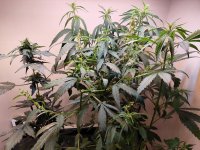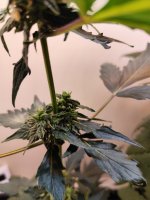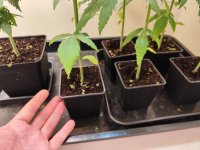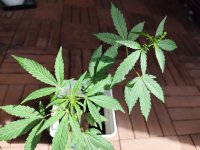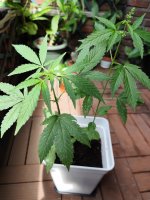Hello everyone, in July last year I planted several strains of hemp in my house (carmagnola, kompolti, tiborszallasi and finola). The first 3 were bigger and slower than I expected. However, I was fascinated by Finola's behavior.
Indoors the males flowered extremely quickly, I had never seen anything like that, dwarf plants with sacks in just 17 days.
The autoflowering trait was not what I had known in common cannabis plants, so I decided to read more about it.
Curiosity led me to make a cross between an autoflowering CBD variety (CBD Auto 20:1 from Fast Bud) and finola. The process lasted 71 days from seed to seed.
34 days ago I planted these F1 seeds with the intention of seeing their behavior, and crossing these F1 again with another Auto CBD 20:1 to simulate a backcross (it is not a real backcross since it is not the same recurring parent, but a sister).
I planted the 20:1 mother 12 days before the F1 to allow for greater flower development prior to pollination.
This is what I have observed in these F1:
- The beginning of flowering of the males has been delayed about 4 days compared to the original Finola. The Finola males sexed at 17 days, and these F1 did so at 21. In both cases pollination began 7 days after sexing.
- The time difference between the sexing of males and females is still very wide, more than I have seen in other varieties. However, this difference is smaller in the same F1 that I have also planted outdoors (42ºN) where they receive fewer hours per day than indoors (18/6).
This makes me think that the autoflowering trait is not the same as in common varieties, where flowering lasts practically the same regardless of the photoperiod.
This fits with the official Finola documentation, which indicates harvest times of 130, 100 and 70 days for latitudes of 60º, 50º and 40º respectively.
Aside from the climate and cold, I think the determining factor is that they have a very high critical photoperiod (maybe near 24h), but they are not really day-neutral plants like common autoflowering ones.
This high critical photoperiod would be responsible for the speed of flowering initiation of this strain.
The literature usually speaks of critical photoperiods of 12 hours for southern varieties, 14 hours for intermediate latitudes, and up to 18 hours for more northern ones. It could be that Finola is between these 18 hours and a real autoflowering plant.
I have read this study where they talk about having identified a second locus (autoflower2) responsible for the Finola trait, which is different from the autoflowering trait of the usual strains (autoflower1).
A FLOWERING LOCUS T ortholog is associated with photoperiod-insensitive flowering in hemp
They speak that while autoflower1 is recesive (aa), autoflower2 is suposed to bee dominant (BB)
If this were true, in the next cross (20:1 x F1) 50% real autoflowering plants should appear.
Assuming aa / BB alleles for Autoflower1 / Autoflower2:
In the actual cross F1 (aabb x AABB) 100% of plants shoul be AaBb
In the next cross "BX1" (aabb x AaBb) should be 4 genotypes, 2 of them real autoflowering (aa in autoflower1):
25% aabb
25% aaBb
25% Aabb
25% AaBb
This is just a guess, since I could be wrong... autoflower2 could not be a single gene like autoflower1, finola could have the autoflower1 masked, or something else... in any case I am eager to harvest these seeds and try them, which will be near September.
I am not an expert and I would like you to discuss my arguments, and thus be able to better understand this incredible strain.
I end the post with some literature:
"The photoperiodic induction of flowering (photoperiodism) can be used to classify plants as short-day (SD) plants, long-day (LD) plants and day-neutral plants. In SD plants, flowering occurs after periods of uninterrupted darkness, while in LD plants, flowering occurs in response to light periods longer than a certain critical length. C. sativa is considered a quantitative SD plant, with genotypes displaying a range of photoperiod thresholds for floral initiation (Amaducci et al., 2008a; Amaducci et al., 2012)"
"Some genotypes have been reported to flower under 18 h of daylight (Chen et al., 2022), while most indoor commercially grown C. sativa plants require a 10-12 h uninterrupted dark period to induce flowering (Salentijn et al., 2019; Moher et al., 2021)."
"Plants from the putative subspecific taxonomic grouping C. sativa var. ruderalis are reported to differ from the photoperiod-sensitive C. sativa var. sativa and C. sativa var. indica subspecies, with flowering induced in response to maturity (e.g., autoflowering) (Gloss, 2015)."
"Ruderalis type plants are termed ‘autoflowering’, owing to their day neutral flowering behavior, and these genotypes are thought to be responsible for the ‘autoflower’ trait in C. sativa populations (Gloss, 2015)."
"It has been proposed that this trait follows a recessive, Mendelian pattern of inheritance, however, there is limited peer reviewed research on this topic (Green, 2015; Toth et al., 2022; Kurtz et al., 2023; Leckie et al., 2023)."
"Hemp photoperiod insensitivity (or ‘autoflowering’) is a recessive Mendelian trait (1:2:1). The Autoflower1 locus was mapped to cs10/CBDRx v2 Chr 1 (17.74- 22.94 Mb) (Toth et al., 2022)."
"Heterozygous Autoflower1 individuals were intermediate for flowering date and homozygotes exhibited earlier flowering behavior (Toth et al., 2022). This is consistent with the segregation of the autoflower trait in other F2 populations (Leckie et al., 2023)."
"Autoflower2 is a locus associated with photoperiod insensitivity in the hemp cultivar ‘FINOLA’. Autoflower2 appears to be dominant given the ability of heterozygotes to flower under continuous light, but the segregation for flowering time within allelic groups suggests that there are additional genes involved in photoperiodic control of flowering. (Dowling et al., 2023). Autoflower2 is distinct from the previously described Autoflower1 on chr01 which was identified in a photoperiod-insensitive high cannabinoid-type hemp accession (Toth et al., 2022)."
"Autoflower1 and Autoflower2 are clearly functionally and phylogenetically distinct from each other. Autoflower1 and Autoflower2 are located on chr01 and chr08, respectively. They fail to complement each other in segregating F2 populations which include non-flowering plants when grown under continuous light. While Autoflower1 is recessive (Toth et al., 2022), Autoflower2 is dominant (Dowling et al., 2023)"
Indoors the males flowered extremely quickly, I had never seen anything like that, dwarf plants with sacks in just 17 days.
The autoflowering trait was not what I had known in common cannabis plants, so I decided to read more about it.
Curiosity led me to make a cross between an autoflowering CBD variety (CBD Auto 20:1 from Fast Bud) and finola. The process lasted 71 days from seed to seed.
34 days ago I planted these F1 seeds with the intention of seeing their behavior, and crossing these F1 again with another Auto CBD 20:1 to simulate a backcross (it is not a real backcross since it is not the same recurring parent, but a sister).
I planted the 20:1 mother 12 days before the F1 to allow for greater flower development prior to pollination.
This is what I have observed in these F1:
- The beginning of flowering of the males has been delayed about 4 days compared to the original Finola. The Finola males sexed at 17 days, and these F1 did so at 21. In both cases pollination began 7 days after sexing.
- The time difference between the sexing of males and females is still very wide, more than I have seen in other varieties. However, this difference is smaller in the same F1 that I have also planted outdoors (42ºN) where they receive fewer hours per day than indoors (18/6).
This makes me think that the autoflowering trait is not the same as in common varieties, where flowering lasts practically the same regardless of the photoperiod.
This fits with the official Finola documentation, which indicates harvest times of 130, 100 and 70 days for latitudes of 60º, 50º and 40º respectively.
Aside from the climate and cold, I think the determining factor is that they have a very high critical photoperiod (maybe near 24h), but they are not really day-neutral plants like common autoflowering ones.
This high critical photoperiod would be responsible for the speed of flowering initiation of this strain.
The literature usually speaks of critical photoperiods of 12 hours for southern varieties, 14 hours for intermediate latitudes, and up to 18 hours for more northern ones. It could be that Finola is between these 18 hours and a real autoflowering plant.
I have read this study where they talk about having identified a second locus (autoflower2) responsible for the Finola trait, which is different from the autoflowering trait of the usual strains (autoflower1).
A FLOWERING LOCUS T ortholog is associated with photoperiod-insensitive flowering in hemp
They speak that while autoflower1 is recesive (aa), autoflower2 is suposed to bee dominant (BB)
If this were true, in the next cross (20:1 x F1) 50% real autoflowering plants should appear.
Assuming aa / BB alleles for Autoflower1 / Autoflower2:
In the actual cross F1 (aabb x AABB) 100% of plants shoul be AaBb
In the next cross "BX1" (aabb x AaBb) should be 4 genotypes, 2 of them real autoflowering (aa in autoflower1):
25% aabb
25% aaBb
25% Aabb
25% AaBb
This is just a guess, since I could be wrong... autoflower2 could not be a single gene like autoflower1, finola could have the autoflower1 masked, or something else... in any case I am eager to harvest these seeds and try them, which will be near September.
I am not an expert and I would like you to discuss my arguments, and thus be able to better understand this incredible strain.
I end the post with some literature:
"The photoperiodic induction of flowering (photoperiodism) can be used to classify plants as short-day (SD) plants, long-day (LD) plants and day-neutral plants. In SD plants, flowering occurs after periods of uninterrupted darkness, while in LD plants, flowering occurs in response to light periods longer than a certain critical length. C. sativa is considered a quantitative SD plant, with genotypes displaying a range of photoperiod thresholds for floral initiation (Amaducci et al., 2008a; Amaducci et al., 2012)"
"Some genotypes have been reported to flower under 18 h of daylight (Chen et al., 2022), while most indoor commercially grown C. sativa plants require a 10-12 h uninterrupted dark period to induce flowering (Salentijn et al., 2019; Moher et al., 2021)."
"Plants from the putative subspecific taxonomic grouping C. sativa var. ruderalis are reported to differ from the photoperiod-sensitive C. sativa var. sativa and C. sativa var. indica subspecies, with flowering induced in response to maturity (e.g., autoflowering) (Gloss, 2015)."
"Ruderalis type plants are termed ‘autoflowering’, owing to their day neutral flowering behavior, and these genotypes are thought to be responsible for the ‘autoflower’ trait in C. sativa populations (Gloss, 2015)."
"It has been proposed that this trait follows a recessive, Mendelian pattern of inheritance, however, there is limited peer reviewed research on this topic (Green, 2015; Toth et al., 2022; Kurtz et al., 2023; Leckie et al., 2023)."
"Hemp photoperiod insensitivity (or ‘autoflowering’) is a recessive Mendelian trait (1:2:1). The Autoflower1 locus was mapped to cs10/CBDRx v2 Chr 1 (17.74- 22.94 Mb) (Toth et al., 2022)."
"Heterozygous Autoflower1 individuals were intermediate for flowering date and homozygotes exhibited earlier flowering behavior (Toth et al., 2022). This is consistent with the segregation of the autoflower trait in other F2 populations (Leckie et al., 2023)."
"Autoflower2 is a locus associated with photoperiod insensitivity in the hemp cultivar ‘FINOLA’. Autoflower2 appears to be dominant given the ability of heterozygotes to flower under continuous light, but the segregation for flowering time within allelic groups suggests that there are additional genes involved in photoperiodic control of flowering. (Dowling et al., 2023). Autoflower2 is distinct from the previously described Autoflower1 on chr01 which was identified in a photoperiod-insensitive high cannabinoid-type hemp accession (Toth et al., 2022)."
"Autoflower1 and Autoflower2 are clearly functionally and phylogenetically distinct from each other. Autoflower1 and Autoflower2 are located on chr01 and chr08, respectively. They fail to complement each other in segregating F2 populations which include non-flowering plants when grown under continuous light. While Autoflower1 is recessive (Toth et al., 2022), Autoflower2 is dominant (Dowling et al., 2023)"
Attachments
Last edited:

